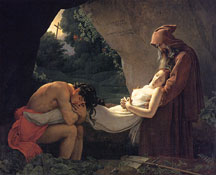Last year, Matthew is in his web design class and while he is listening to his teacher heÃs also surfing the net. He stumbles on someoneÃs home site with links to music and photos. Matt clicks on ìPeople I know and You DonÃt, î and standing among folks Matt truly does not know is a year old photo of his web design teacher.

The Burial of Atala, 1767.
Anne-Louis Girodet De Roucy-Trioson
View larger image

Gorgeous details and tones, but dull expressions, and Girodet sure needed lessons in light and shadow from Harmenszoon……..
I don’t know that the odds are so astronomical — the small world aspects all make a certain amount of sense. Another perspective would be to ask how likely anybody else in that class would be to design a site with a similar link.
Critic, got worms?
…you early bird.
From the Getty Museum: http://www.getty.edu/art/collections/objects/o836.html
Interesting in both their reproduction on the web and a brief description of the painting. Found this too: ” A contemporary critic viewing Burial of Atala of 1808 described Girodet’s style as having a “precision of drawing reminiscent of the masterpieces of antiquity, a fresh coloring, a studied effect, and a brush stroke at once generous, fluent, and delicate.” The picture won the LÈgion d’Honneur. In 1812 Girodet inherited a fortune, painted less, and dedicated himself increasingly to writing tedious poems on aesthetics in a house shuttered to daylight.”
I so identify with that last sentence. All I need is that inherited fortune.
You’d never survive “a house shuttered to daylight”, Mikey, fortune or no fortune. Now tedious poetry I could see……….
I guess I understand its technique winning it prizes, but when one looks at the rich darknesses in a Rembrandt, which perhaps overstate contrast, only an injudicious boosting of levels in Photoshop would achieve the amount of detail implausibly visible on the seated, half-naked male figure of Chactas. Or any of the foreground, for that matter, unless this be not a cave, but an arch, with some second source of light. He tried to invoke shadow with the one dark wall, and then took massive liberties elsewhere to allow himself to paint sumptuous detail. I stumbled upon the same link you note above and immediately saw how different the rendition is — but it’s a copy by an unnamed artist, with a different (better?) treatment of shadows, though still implausibe (especially if that’s supposed to be moonlight, as asserted elsewhere).
And who knew they had Prozac in late 18th-century America? I mean, does anybody here really look like they feel any strong emotion evincing the tragic?
But I rant from my soapbox alone — from yet another review online, presumably by a much more qualified, obviously more impressed critic:
“Mourning and sacrifice are the themes of The Entombment of Atala, the moving picture that David’s pupil Girodet showed at the Paris Salon in 1808. The scene is set in America, the Native American brave Chactas mourns, clasping the legs of his lover, the half-Spanish converted Christian Atala, who expires before him, comforted by a friar. He is not virtuous: he has violated her vow to remain a virgin or die, and as she meets her punishment his lithe sexuality and dangerous power can still be felt. With its wild New World setting, intensely realized emotions and almost supernatural lighting, the picture moves outside classical rules to contrast ‘civilization’ and ‘barbarism’ in highly ambivalent terms.
Girodet took his richly suggestive narrative from a popular story published seven years earlier by Chateaubriand, who had gone to America in 1791 to escape the Revolution.”
YouÃre right about the lighting, but had you not elaborated I would have thought, this painter, as most painters, but certainly ones whose lives depended on natural light, and the inadequacies of vegetable or whale oil or kerosene, would represent it most accurately. What is more important than light and shadow to a painting?
But I guess for me, it matters not. Can you look at the painting without thinking about how it couldnÃt be? Or given his care to every other detail, do you keep thinking he should have taken up tedious poetry earlier?
I’m no hardened critic, unwilling to engage a work emotionally — I even cry at cheap sentimentalism in bad movies sometimes. But while the thumbnail reads well, and the story’s quite touching, this work seems so timid up close, the characters inert, the color flat. Technique is quite beside the point. I don’t ask for realism — what’s realistic in Rembrandt, where darkness is a character? — and I’m no kneejerk proponent of verite. Artistic license that advances emotion or understanding is part of art, necessary as breathing. I just think this painter killed this subject (which hasn’t deterred my beating its dead carcass…… but I’m done).
Post more. I’ll bite my tongue and listen to others’ appreciations.